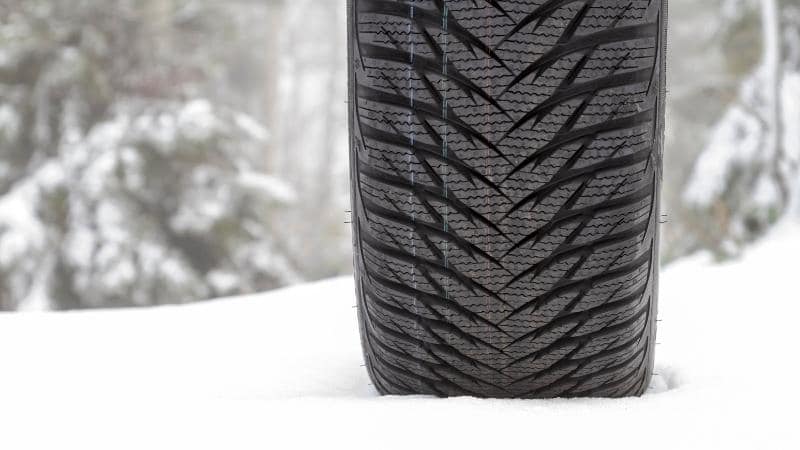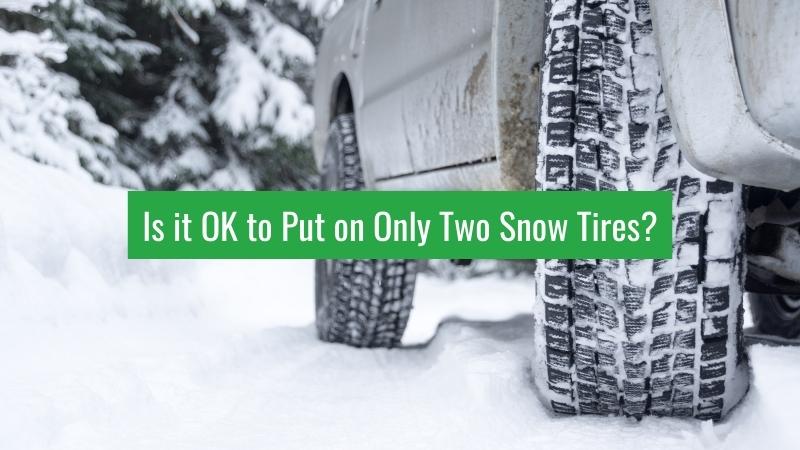As a driver, you may be wondering whether it’s okay to install only two snow tires on your vehicle for winter driving.
It’s a common misconception that putting snow tires on just the driving wheels is sufficient for adequate traction and control in colder months. However, this practice can lead to potentially dangerous situations and should be avoided.
To understand why it’s critical to have all four tires fitted with snow tires, consider the impact on various aspects of vehicle control.
When you fit only the front or rear wheels with snow tires, your vehicle’s handling can become unbalanced, leading to problems such as oversteering or fishtailing around corners, even at low speeds. Les Schwab explains that installing snow tires on the front and not all four wheels can cause hazardous driving conditions in certain weather situations.
Moreover, having just two snow tires can also compromise your ability to brake effectively on slippery surfaces. When it comes to winter driving, it’s essential to prioritize both handling stability and braking performance for a safe and smooth experience.
Understanding Snow Tires
Benefits and Purpose
Snow tires, also known as winter tires, are designed specifically to provide better traction, grip, and braking performance in cold, snowy, and icy conditions. These tires are made of softer rubber compounds that remain flexible in colder temperatures, allowing them to better conform to the road surface and maintain grip.
By equipping your vehicle with snow tires, you can significantly improve your driving safety and control during winter months.
Snow tires not only offer better traction on snowy and icy roads but also improve braking distances and help minimize the risk of skids, fishtailing, or losing control of your vehicle.
Snow Tire Types
There are two primary types of snow tires: studded and studless. Both types offer unique benefits and drawbacks, which are worth considering before choosing the right ones for your vehicle.
- Studded snow tires: These tires have metal studs embedded in the tread designed to dig into icy surfaces, providing exceptional grip on slippery roads. However, studded tires may produce noise and can cause damage to dry, non-icy road surfaces. In some regions, the use of studded tires may be restricted due to the potential for road damage.
- Studless snow tires: Studless snow tires rely on advanced rubber compounds and tread patterns to maintain grip on snowy and icy surfaces. They provide excellent traction without the drawbacks of studded tires. Studless snow tires are suitable for most winter driving conditions and are generally quieter and less damaging to road surfaces compared to studded options.
When selecting snow tires for your vehicle, consider your specific driving needs, local climate conditions, and any applicable legislative restrictions on tire use.
By choosing the right set of snow tires and ensuring proper installation, you will significantly improve your driving safety and comfort during the challenging winter months.
Two Snow Tires Vs. Four Snow Tires
Handling and Performance
When considering whether to use two or four snow tires on your vehicle, it’s important to think about the impact on handling and performance.
Installing two snow tires on just the front or rear wheels can lead to an imbalance in traction. This could cause your car to fishtail, spin out or handle poorly when cornering or braking in winter conditions, especially on ice and snow-covered roads.
On the other hand, using four snow tires ensures that all wheels have the same level of traction, providing better steering control, balance, and consistency in performance.
This will help you maintain control of your vehicle in various winter situations such as accelerating, braking, or turning on slippery surfaces.
Safety Concerns
Safety should be a top priority when making decisions about your vehicle’s winter setup. Installing snow tires on only the front or back wheels presents safety hazards. A mismatch in traction between the front and rear tires could lead to a loss of control, putting you and your passengers at risk.
By equipping your vehicle with four snow tires, you’re lowering the risks associated with the imbalance of traction. This setup allows for better vehicle stability and reduces the chances of encountering accidents due to poor road conditions in winter.
In conclusion, while it might be tempting to save money by installing only two snow tires, doing so can negatively affect your vehicle’s handling and compromise your safety. It is strongly recommended to always use four snow tires during winter for improved performance and safety.
Guidelines for Snow Tire Installation

Front-Wheel Drive Vehicles
For front-wheel drive vehicles, it might be tempting to install snow tires on the front wheels only. However, this is not recommended.
Installing snow tires only on the front wheels can cause oversteering or fishtailing around corners or when applying the brakes in certain weather conditions, even at low speeds. To ensure balanced handling and overall safety, always install snow tires on all four wheels.
Rear-Wheel Drive Vehicles
With rear-wheel drive vehicles, using only two snow tires on the rear wheels is also a bad idea.
Just like with front-wheel drive vehicles, having snow tires on only the rear wheels can lead to oversteering or fishtailing in winter conditions, making your vehicle harder to control. For optimal safety and performance, use snow tires on all four wheels.
All-Wheel Drive Vehicles
All-wheel drive vehicles benefit from having snow tires on all four wheels as well. Although all-wheel drive can provide better traction in low-traction situations, it cannot compensate for the disadvantages of using uneven tire types or traction levels.
For the best performance and safety, use a full set of snow tires on your all-wheel drive vehicle.
In summary, regardless of your vehicle’s drive type, installing snow tires on all four wheels is necessary for optimal performance, safety, and control during winter conditions.
Conclusion
In the end, it’s important to prioritize your safety and the safety of others on the road during winter conditions. While you might be tempted to save money by only installing two snow tires, doing so can actually put you in danger.
When you have snow tires on just the front or rear wheels, your vehicle’s handling and overall stability will be compromised, especially when navigating through turns or applying brakes in wintry weather conditions.
As Les Schwab and Tires Plus explain, having only two snow tires can lead to oversteering or fishtailing, which can result in accidents.
To maintain optimal control and grip on slippery surfaces, it’s highly recommended to install snow tires on all four wheels. This provides a more uniform and balanced level of traction, enhancing your vehicle’s performance and responsiveness.
In cases where you’re unable to use four snow tires, experts recommend placing the two tires on the rear wheels, as explained by The Weather Network. However, this option is far from ideal, and the safest course of action is still to use a full set of snow tires.
Therefore, to ensure the best possible driving experience and to minimize the risk of accidents in winter conditions, invest in a complete set of snow tires for your vehicle.
Your safety and the well-being of those around you depend on your ability to make responsible choices when it comes to tire selection and maintenance.
Hi, my name is Niklas, the head content creator & CEO of Whirling Wheelz. I am very interested in vehicles of all kinds, mainly cars. I have a car mechanics degree from high school and a big hobby of mine is to follow the WRC (World Rally Championship) both online and through travel.

